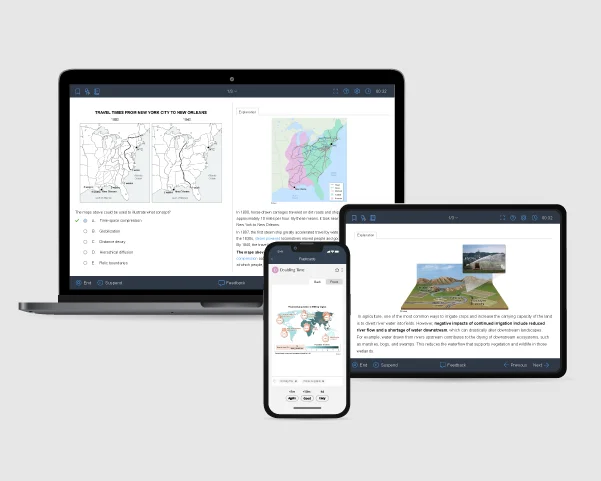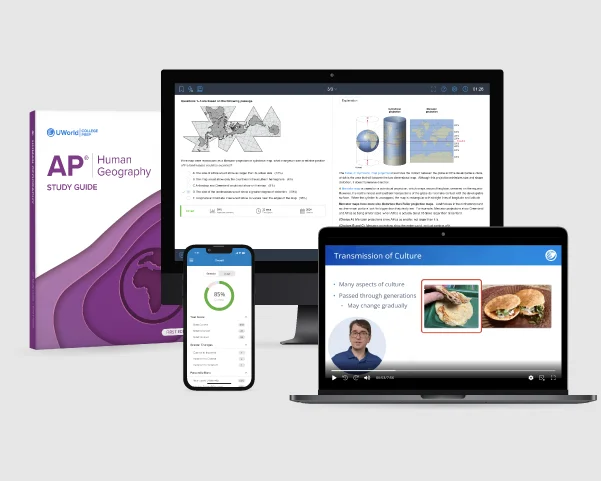AP Human Geography is a challenging and rewarding social sciences course. It is one of the most popular social studies courses students can take during their high school career. In 2024, 56.1% of students who took the AP Human Geography exam worldwide scored a 3 or higher. Instead of 9th grade Social Studies, students could take AP Human Geography for an entire school year.
The AP HUG course is equivalent to a college-level introductory human geography course. It teaches students how to investigate patterns and processes that describe how societies perceive, use, and alter the Earth's surface. Since the exam assesses students' understanding of course concepts and objectives, developing a good understanding of the AP Human Geography key concepts is important. Practice tests are a great tool to help you prepare for the final exam. Students who practice for exams ahead of time are more confident and prepared than those who don’t.
What Are the AP Human Geography Course Skills?
The AP Human Geography curriculum is based on the National Geography Standards, which were published in 1994 and updated in 2012. The five skill categories and associated skills that AP Human Geography students must master are outlined below.
Skill Category 1: Concepts and Processes
This category requires examining geographical theories, methodologies, ideas, mechanisms, and frameworks within both theoretical and practical applications.
Skills:
- Describe geographical concepts, procedures, prototypes, and theories.
- Explain geographical concepts, procedures, prototypes, and theories.
- Compare geographical concepts, processes, models, and theories.
- Describe appropriate geographic concepts, processes, models, or theories in a given context.
- Explain the advantages, disadvantages, and limitations of geographic models and theories in a given context.
Skill Category 2: Spatial Relationships
This category requires analyzing and applying geographical patterns, connections, and outcomes in different contexts.
Skills:
- Describe spatial patterns, networks, and connections.
- Define spatial relationships in a specified context or region with the help of geographic concepts, processes, models, or theories.
- Describe the likely outcome of a geographical scenario with the help of geographic concepts, processes, models, or theories.
- Clarify the significance of geographic similarities and differences between various locations and/or time periods.
- Describe the extent to which a geographic concept, process, model, or theory effectively explains geographic effects in different global contexts and regions.
Skill Category 3: Data Analysis
This category requires understanding and analyzing quantitative geographic data shown on maps, tables, charts, graphs, satellite images, and infographics.
Skills:
- Determine the various types of data presented in maps, quantitative data, and geospatial data.
- Explain spatial patterns shown in maps and in quantitative and geospatial data.
- Describe patterns and trends in quantitative and geospatial data and on maps to draw conclusions.
- Compare patterns and trends in maps and quantitative and geospatial data and draw conclusions.
- Describe the geographic principles, processes, and outcomes that maps and data imply or illustrate.
- Describe any potential limitations of the provided data.
Skill Category 4: Source Analysis
This requires analyzing and interpreting geographic information in maps, images (e.g., satellites, photographs, cartoons), and landscapes.
Skills:
- Use visual sources to identify the different kinds of information they contain.
- Describe spatial patterns given in visual sources.
- Analyze visual sources for patterns and trends to draw conclusions.
- Draw conclusions by comparing visual patterns and trends.
- Use maps and images as a way to illustrate or explain geographic principles, processes, and outcomes.
- Define the potential limitations of the provided visual sources.
Skill Category 5: Scale Analysis
This requires explaining spatial relationships at various geographic scales by examining geographic theories, approaches, concepts, processes, and models.
Skills:
- Identify the analysis given in maps, quantitative and geospatial data, and images and landscapes.
- Use geographic concepts, processes, models, or theories to explain spatial relationships at different geographic scales.
- Compare features and processes of geography at different geographic scales.
- Explain how well a geographic idea, process, model, or theory explains the effects of geography at different geographic scales.
AP Human Geography - Three Big Ideas
The big ideas unify the course and are referred to frequently throughout the course. They serve as the foundation of the course and facilitate meaningful connections between different concepts. Students are able to develop profound conceptual knowledge by revisiting and applying the big ideas in a range of circumstances. The following is a concise explanation of each of the major themes of the course.
Big Idea 1: Patterns and Spatial Organization (PSO)
Human Society and spatial patterns are organized by political, historical, cultural, and economic influences.
Big Idea 2: Impacts and Interactions (IMP)
Complex cause-and-effect relationships exist between people, their environments, and historical and contemporary behavioral patterns.
Big Idea 3: Spatial Process and Societal Change (SPS)
A spatial perspective investigates how phenomena are related in specific locations in order to investigate human organization and its environmental consequences.

AP Human Geography - Seven Units and Topics
The course content is divided into seven units, typically like the content organized in college courses and textbooks. Each unit's teachable content is represented by its "topics." While most of the AP Human Geography topics and key concepts may be covered in one or two class periods, the course’s pace is adjusted to match the needs of the institution. Here are the seven AP Human Geography units, their topics and respective weights on the multiple-choice section.
Unit 1: Thinking Geographically
(8–10% | class periods: ~9–10)
Unit 1 introduces the fundamental principles of the course, which revolve around the geographic study of places. Emphasizing the "why of where," this unit aims to cultivate a geographic perspective among students. It highlights the importance of applying a spatial approach when evaluating both qualitative and quantitative data. Students gain insights into how this information influences policy decisions and explore the reciprocal relationship between human activities and the environment. Here are the topics, big ideas, and suggested skills for this unit:
| Big Ideas Explored | Topic | Skill Category | ||
|---|---|---|---|---|
| Big Idea 2: IMP | 1.1 | Introduction to Maps | 3.A | Determine the various types of data presented in maps, quantitative data, and geospatial data. |
| 1.2 | Geographic Data | 3.A | Determine the various types of data presented in maps, quantitative data, and geospatial data. | |
| 1.3 | The Power of Geographic Data | 3.B | Explain spatial patterns shown in maps and in quantitative and geospatial data. | |
| Big Idea 1: PSO | 1.4 | Spatial Concepts | 3.B | Explain spatial patterns shown in maps and in quantitative and geospatial data. |
| 1.5 | Human–Environmental Interaction | 1.B | Explain geographical concepts, procedures, prototypes, and theories. | |
| 1.6 | Scales of Analysis | 5.A | Identify the analysis given in maps, quantitative and geospatial data, and images and landscapes. | |
| Big Idea 3: SPS | 1.7 | Regional Analysis | 1.A | Describe geographical concepts, procedures, prototypes, and theories. |
Unit 2: Population and Migration Patterns and Processes
(12–17% | class periods: ~19 - 20)
Unit 2 focuses on the trends observed in human populations and the factors influencing population changes. In this unit, students learn to analyze population distributions across various scales, ranging from local to global, and employ population pyramids to grasp age-sex structures. Students also get an understanding of migration patterns and investigate the causes behind voluntary and forced relocations and the consequences for existing settlements. Here are the topics, big ideas, and suggested skills for this unit:
| Big Ideas Explored | Topic | Skill Category | ||
|---|---|---|---|---|
| Big Idea 1: PSO | 2.1 | Population Distribution | 3.A | Determine the various types of data presented in maps, quantitative data, and geospatial data. |
| 2.2 | Consequences of Population Distribution | 2.C | Describe the likely outcome of a geographical scenario with the help of geographic concepts, processes, models, or theories. | |
| 2.3 | Population Composition | 2.A | Describe spatial patterns, networks, and connections | |
| Big Idea 2: IMP | 2.4 | Population Dynamics | 3.C | Describe patterns and trends in quantitative and geospatial data and on maps to draw conclusions. |
| 2.5 | The Demographic Transition Model | 3.B | Explain the spatial patterns shown in maps and in quantitative and geospatial data. | |
| 2.6 | Malthusian Theory | 2.B | Define spatial relationships in a specified context or region with the help of geographic concepts, processes, models, or theories. | |
| Big Idea 3: SPS | 2.7 | Population Policies | 2.C | Describe the likely outcome of a geographical scenario with the help of geographic concepts, processes, models, or theories. |
| 2.8 | Women and Demographic Change | 3.B | Explain the spatial patterns shown in maps and in quantitative and geospatial data. | |
| 2.9 | Aging Populations | 2.C | Describe the likely outcome of a geographical scenario with the help of geographic concepts, processes, models, or theories. | |
| Big Idea 2: IMP | 2.10 | Causes of Migration | 2.B | Define spatial relationships in a specified context or region with the help of geographic concepts, processes, models, or theories. |
| 2.11 | Forced and Voluntary Migration | 1.D | Describe appropriate geographic concepts, processes, models, or theories in a given context. | |
| 2.12 | Effects of Migration | 2.B | Define spatial relationships in a specified context or region with the help of geographic concepts, processes, models, or theories. | |
Unit 3: Cultural Patterns and Processes
(12–17% | class periods: ~19–20)
Unit 3 delves into the formation of distinct cultural identities through examining cultural patterns and processes. It analyzes the impact of geographical location and available resources on cultural practices, offering insights into the evolution of cultural landscapes over time. Students examine historical images from various places to understand the attributes contributing to their comprehension of cultural patterns and processes. Students also learn about the distribution and diffusion of cultural practices and investigate the reasons and consequences of their dissemination. Here are the topics, big ideas, and suggested skills for this unit:
| Big Ideas Explored | Topic | Skill Category | ||
|---|---|---|---|---|
| Big Idea 1: PSO | 3.1 | Introduction to Culture | 4.A | Use visual sources to identify the different kinds of information they contain. |
| 3.2 | Cultural Landscapes | 4.B | Describe spatial patterns given in visual sources. | |
| 3.3 | Cultural Patterns | 4.C | Analyze visual sources for patterns and trends that can help you draw conclusions. | |
| Big Idea 2: IMP | 3.4 | Types of Diffusion | 1.D | Describe appropriate geographic concepts, processes, models, or theories in a given context. |
| Big Idea 3: SPS | 3.5 | Historical Causes of Diffusion | 2.C | Describe the likely outcome of a geographical scenario with the help of geographic concepts, processes, models, or theories. |
| 3.6 | Contemporary Causes of Diffusion | 5.B | Use geographic concepts, processes, models, or theories to explain spatial relationships at different geographic scales. | |
| Big Idea 2: IMP | 3.7 | Diffusion of Religion and Language | 4.E | Use maps and images as a way to illustrate or explain geographic principles, processes, and outcomes. |
| Big Idea 3: SPS | 3.8 | Effects of Diffusion | 2.B | Define spatial relationships in a specified context or region with the help of geographic concepts, processes, models, or theories. |
Unit 4: Political Patterns and Processes
(12–17% | class periods: ~19–20)
Unit 4 primarily focuses on the political organization of the world. Students analyze the current political map to understand how territoriality influences political power and affects the identity of different groups. Students also examine political boundaries, their functions, and scales, learning to understand the interplay between political and cultural influences, resulting in boundary tensions. Additionally, students explore different forms of government and how forces like devolution can impact political units and existing boundaries. Here are the topics, big ideas, and suggested skills for this unit:
| Big Ideas Explored | Topic | Skill Category | ||
|---|---|---|---|---|
| Big Idea 1: PSO | 4.1 | Introduction to Political Geography | 4.A | Use visual sources to identify the different kinds of information they contain. |
| 4.2 | Political Processes | 3.E | Describe the geographic principles, processes, and outcomes that maps and data imply or illustrate. | |
| 4.3 | Political Power and Territoriality | 5.B | Use geographic concepts, processes, models, or theories to explain spatial relationships at different geographic scales. | |
| Big Idea 2: IMP | 4.4 | Defining Political Boundaries | 1.D | Describe appropriate geographic concepts, processes, models, or theories in a given context. |
| 4.5 | The Function of Political Boundaries | 5.D | Explain how well a geographic idea, process, model, or theory explains the effects of geography at different geographic scales. | |
| 4.6 | Internal Boundaries | 5.A | Identify the analysis given in maps, quantitative and geospatial data, and images and landscapes. | |
| 4.7 | Forms of Governance | 2.A | Describe the spatial patterns, networks, and connections. | |
| Big Idea 3: SPS | 4.8 | Defining Devolutionary Factors | 3.E | Describe the geographic principles, processes, and outcomes that maps and data imply or illustrate. |
| 4.9 | Challenges to Sovereignty | 5.C | Compare features and processes of geography at different sizes. | |
| 4.10 | Consequences of Centrifugal and Centripetal Forces | 5.C | Compare features and processes of geography at different sizes. | |
Unit 5: Agriculture and Rural Land-Use Patterns and Processes
(12–17% | class periods: ~19–20)
Unit 5 focuses on the origins and spread of agriculture. Students explore how historical changes in agricultural practices, driven by the positives and negatives of technological advancements, have impacted the global markets. They develop an understanding of the economic and technological influences that affect agricultural regions, resulting in larger operations and increased land carrying capacity, ultimately establishing a global agricultural system with interconnected regions for production and consumption. Here are the topics, big ideas, and suggested skills for this unit:
| Big Ideas Explored | Topic | Skill Category | ||
|---|---|---|---|---|
| Big Idea 1: PSO | 5.1 | Introduction to Agriculture |
2.D | Clarify the significance of geographic similarities and differences between various locations and/or time periods. |
| 5.2 | Settlement Patterns and Survey Methods |
4.D | Draw conclusions by comparing visual patterns and trends. | |
| Big Idea 2: IMP | 5.3 | Agricultural Origins and Diffusions | 2.B | Define spatial relationships in a specified context or region with the help of geographic concepts, processes, models, or theories. |
| 5.4 | The Second Agricultural Revolution | 4.D | Draw conclusions by comparing visual patterns and trends. | |
| 5.5 | The Green Revolution | 2.D | Clarify the significance of geographic similarities and differences between various locations and/or time periods. | |
Big Idea 3: SPS |
5.6 | Agricultural Production Regions | 2.E | Describe the extent to which a geographic concept, process, model, or theory effectively explains geographic effects in different global contexts and regions. |
| 5.7 | Spatial Organization of Agriculture | 2.D | Clarify the significance of geographic similarities and differences between various locations and/or time periods. | |
| 5.8 | Von Thünen Model | 5.B | Use geographic concepts, processes, models, or theories to explain spatial relationships at different geographic scales. | |
| 5.9 | The Global System of Agriculture | 5.D | Explain how well a geographic idea, process, model, or theory explains the effects of geography at different geographic scales. | |
| Big Idea 2: IMP | 5.10 | Consequences of Agricultural Practices | 2.E | Describe the extent to which a geographic concept, process, model, or theory effectively explains geographic effects in different global contexts and regions. |
| 5.11 | Challenges of Contemporary Agriculture | 4.D | Draw conclusions by comparing visual patterns and trends. | |
| 5.12 | Women in Agriculture | 3.D | Compare patterns and trends in maps and quantitative and geospatial data to draw conclusions. | |
Unit 6: Cities and Urban Land-Use Patterns and Processes
(12–17% | class periods: ~19–20)
Unit 6 focuses on the origins of urban settlements and their influences and impact on globalization. Students analyze how major cities are spatially distributed worldwide and explore the patterns of connectivity and accessibility. They identify development patterns and evaluate their economic and political significance at regional, national, and international scales. This unit also explores the challenges faced by cities, along with the sustainability issues resulting from urban growth. Here are the topics, big ideas, and suggested skills for this unit:
| Big Ideas Explored | Topic | Skill Category | ||
|---|---|---|---|---|
| Big Idea 1: PSO | 6.1 | The Origin and Influences of Urbanization | 2.D | Clarify the significance of geographic similarities and differences between various locations and/or time periods. |
| 6.2 | Cities Across the World | 2.D | Clarify the significance of geographic similarities and differences between various locations and/or time periods. | |
| 6.3 | Cities and Globalization | 5.B | Use geographic concepts, processes, models, or theories to explain spatial relationships at different geographic scales. | |
| 6.4 | The Size and Distribution of Cities | 2.C | Describe the likely outcome of a geographical scenario with the help of geographic concepts, processes, models, or theories. | |
| 6.5 | 5 The Internal Structure of Cities | 1.E | Explain the advantages, disadvantages, and limitations of geographic models and theories in a given context. | |
| Big Idea 2: IMP | 6.6 | Density and Land Use | 3.D | Compare patterns and trends in maps and quantitative and geospatial data to draw conclusions. |
| 6.7 | Infrastructure | 3.C | Describe patterns and trends in quantitative and geospatial data and on maps to draw conclusions. | |
| 6.8 | Urban Sustainability | 2.C | Describe the likely outcome of a geographical scenario with the help of geographic concepts, processes, models, or theories. | |
| 6.9 | Urban Data | 3.E | Describe the geographic principles, processes, and outcomes that maps and data imply or illustrate. | |
| Big Idea 3: SPS | 6.10 | Challenges of Urban Changes | 4.E | Use maps and images as a way to illustrate or explain geographic principles, processes, and outcomes. |
| 6.11 | Challenges of Urban Sustainability | 2.D | Clarify the significance of geographic similarities and differences between various locations and/or time periods. | |
Unit 7: Industrial and Economic Development Patterns and Processes
(12–17% | class periods: ~19–20)
Unit 7 emphasizes the origins and influences of industrial development and its significance in economic development and globalization. Students draw upon concepts from the political unit to grasp measures of social and economic development and explore various theories. They learn about contemporary spatial patterns of industrialization and their impact on uneven development of the world. The unit also utilizes quantitative data and statistics to understand spatial relationships in the global market and explores strategies for sustainable development, with an emphasis on areas like women, children, health, education, environment, and global cooperation. Here are the topics, big ideas, and suggested skills for this unit:
| Big Ideas Explored | Topic | Skill Category | ||
|---|---|---|---|---|
| Big Idea 3: SPS | 7.1 | The Industrial Revolution | 4.D | Draw conclusions by comparing visual patterns and trends. |
| 7.2 | Economic Sectors and Patterns | 2.B | Define spatial relationships in a specified context or region with the help of geographic concepts, processes, models, or theories. | |
| 7.3 | Measures of Development | 3.F | Describe any potential limitations of the provided data. | |
| 7.4 | Women and Economic Development | 3.D | Compare patterns and trends in maps and quantitative and geospatial data to draw conclusions. | |
| 7.5 | Theories of Development | 1.E | Explain the advantages, disadvantages, and limitations of geographic models and theories in a given context. | |
Big Idea 1: PSO |
7.6 | Trade and the World Economy | 5.B | Use geographic concepts, processes, models, or theories to explain spatial relationships at different geographic scales. |
| 7.7 | Changes as a Result of the World Economy | 4.F | Define the potential limitations of the provided visual sources. | |
| Big Idea 2: IMP | 7.8 | Sustainable Development | 5.D | Explain how well a geographic idea, process, model, or theory explains the effects of geography at different geographic scales. |
Master all seven AP Human Geography units effortlessly with our AP HUG prep course, which comes with video lessons, a comprehensive study guide, and an extensive QBank. Tailored to enhance your understanding and knowledge retention, our practice questions will give you an edge to score big on the AP Human Geography exam.

Frequently Asked Questions (FAQs)
Is AP Human Geography an easy course?
What are the themes of AP Human Geography?
Themes are presented as the big ideas of the course’s framework. The following are the themes for AP Human Geography:
- Big Idea 1: Patterns and Spatial Organization (PSO)
- Big Idea 2: Impacts and Interactions (IMP)
- Big Idea 3: Spatial Process and Societal Change (SPS)
What are the most important topics in AP Human Geography?
These are the AP Human Geography topics that may be covered in each of the seven units and their weights.
- Unit 1: Thinking Geographically (8–10%)
- Unit 2: Population and Migration Patterns and Processes (12–17%)
- Unit 3: Cultural Patterns and Processes (12–17%)
- Unit 4: Political Patterns and Processes (12–17%)
- Unit 5: Agriculture and Rural Land-Use Patterns and Processes (12–17%)
- Unit 6: Cities and Urban Land-Use Patterns and Processes (12–17%)
- Unit 7: Industrial and Economic Development Patterns and Processes (12–17%)
References
- (2024). AP Score Distributions. apstudents.collegeboard.org. Retrieved December 12, 2024, from https://apstudents.collegeboard.org/about-ap-scores/score-distributions
- (2020, Fall). AP® Human Geography Course and Exam Description. apcentral.collegeboard.org. Retrieved December 12, 2024, from https://apcentral.collegeboard.org/media/pdf/ap-human-geography-course-and-exam-description.pdf
Read More About AP Human Geography
AP Human Geography Study Plan & Tips
A thorough study guide with tips and advice can help you score 5 easily. See how to prepare effectively for the AP Human Geography exam by using our expert-made study guide.
AP Human Geography Exam Format
If you are familiar with the test's structure, it will increase your chances of getting a high score. Here’s a guide that covers everything from exam format to question types.
AP Human Geography Scoring Guide
Interested in learning about AP Human Geography scoring? This scoring guide has everything you need —including a score calculator to easily predict your scores.
Best AP Human Geo Study Guide Comparison
Explore top AP Human Geo study guides to find the best resources for the exam. Compare features, pros, cons and reviews to select the perfect guide for success.
Best AP Human Geo Prep Course Review
Searching for top AP Human Geo prep courses? Read this review to compare the best courses and choose the perfect one for your success.
How to Self-Study for AP Human Geo
Learn how to self-study for AP Human Geography like a pro! Follow this comprehensive plan filled with tips, tools, and resources for success.




